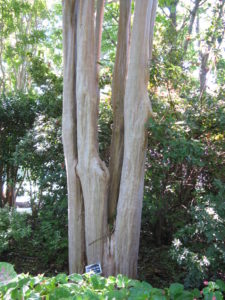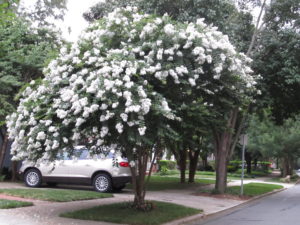Crape Myrtle Hardiness: Know how hardy the cultivar is. USDA hardiness zones 6 to 9).
Site Location: Crape myrtles love sunlight. Flower numbers decline in light to medium shade. Plant in average soil that is well-drained. Select the right cultivar that fits the allotted planting space. Mulch plant and water as needed the first growing season.
Planting Time: In most regions plant in early- to mid-spring. Summer and early fall will also work in southern areas. Water newly planted crape myrtle deeply at planting time and mulch around them to conserve soil moisture and prohibit weeds. Apply a granular fertilizer such as 10-10-10 or equivalent in early spring. Keep plant(s) irrigated through the summer months.
Pruning crape myrtles: grow naturally as small upright or vase shaped trees with multiple trunks (except small shrub types). Late winter (late February thru March) is the best time to prune crape myrtles. Crapemyrtles generally require only minimum pruning annually. STOP THE CHOP! –do not prune back crape myrtles to the same point every spring as you often see landscapers doing at shopping malls and industrial buildings. This is “crape murder.” Removing seedpods is an optional activity.
Avoid Disease / Insect Problems
In general, crape myrtles contact few disease and insect problems if you select the best cultivars for the area where you garden. In southerly regions (zones 7-9) inspect newly emerging spring foliage for crape myrtle aphids, particularly on the leaf underside. Sooty mold fungus usually follows. Leaves and stems turn black, that is clear evidence of aphid feedings. Aphids are rarely seen in northern areas (zone 6).
Aphid Resistant Cultivars: ‘Muskogee,’ ‘Natchez,’ ‘Tuscarora,’ ‘Acoma,’ ‘Tuskegee,’ ‘Hopi,’ ‘Zuni,’ ‘Biloxi,’ ‘Miami,’ ‘Wichita,’ ‘Apalachee,’ ,’Lipan,’ ‘Osage,’ ‘Sioux,’ ‘Yuma,’ ‘Tonto,’ and ‘Fantasy.’ Target aphids using any of the following insecticides: malathion, diazinon, or summer horticultural oils. Read and follow package directions.
Crape Myrtle Bark Scale is becoming a significant problem in the deep South.
Powdery Mildew Resistant Cultivars: ‘Hopi’, ‘Lipan’, ‘Osage’, ‘Regal Red’, ‘Sioux’, ‘Tonto’, ‘Tuscarora’, ‘Tuskegee’, ‘Apalachee’, and ‘Fantasy’. For susceptible cultivars, spray leaves at first sign of disease with Funginex™, Immunox™, Bayleton™, or Strike™ to reduce the spread of powdery mildew; repeat spraying as necessary.
Cercospora Leaf Spot Resistant Cultivars: ‘Fantasy,’ ‘Tonto,’ ‘Tuscarora,’ ‘Tuskegee’, among others.
Credit: South Carolina Extension for listing of disease and insect resistant cultivars.



 Posted in
Posted in 
